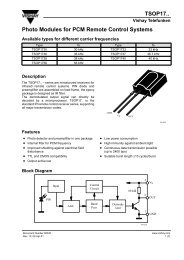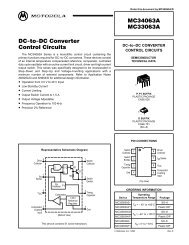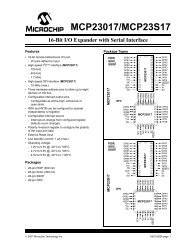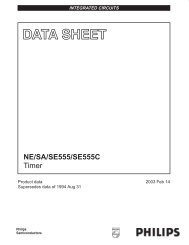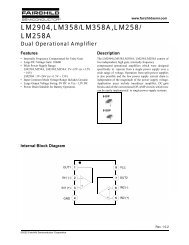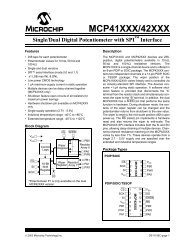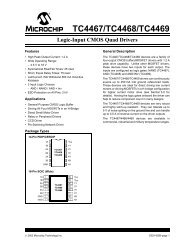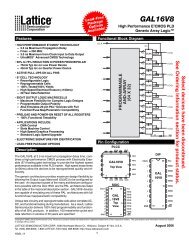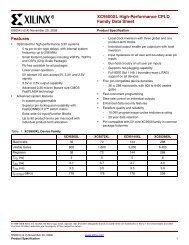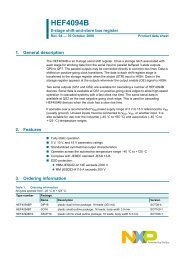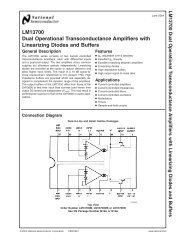PSoC™ Mixed-Signal Array Final Data Sheet - svn
PSoC™ Mixed-Signal Array Final Data Sheet - svn
PSoC™ Mixed-Signal Array Final Data Sheet - svn
You also want an ePaper? Increase the reach of your titles
YUMPU automatically turns print PDFs into web optimized ePapers that Google loves.
CY8C29x66 <strong>Final</strong> <strong>Data</strong> <strong>Sheet</strong> PSoC Overview<br />
tors, to simplify programming of real time embedded events.<br />
Program execution is timed and protected using the included<br />
Sleep and Watch Dog Timers (WDT).<br />
Memory encompasses 32 KB of Flash for program storage, 2<br />
KB of SRAM for data storage, and up to 2 KB of EEPROM emulated<br />
using the Flash. Program Flash utilizes four protection levels<br />
on blocks of 64 bytes, allowing customized software IP<br />
protection.<br />
The PSoC device incorporates flexible internal clock generators,<br />
including a 24 MHz IMO (internal main oscillator) accurate<br />
to 2.5% over temperature and voltage. The 24 MHz IMO can<br />
also be doubled to 48 MHz for use by the digital system. A low<br />
power 32 kHz ILO (internal low speed oscillator) is provided for<br />
the Sleep timer and WDT. If crystal accuracy is desired, the<br />
ECO (32.768 kHz external crystal oscillator) is available for use<br />
as a Real Time Clock (RTC) and can optionally generate a crystal-accurate<br />
24 MHz system clock using a PLL. The clocks,<br />
together with programmable clock dividers (as a System<br />
Resource), provide the flexibility to integrate almost any timing<br />
requirement into the PSoC device.<br />
PSoC GPIOs provide connection to the CPU, digital and analog<br />
resources of the device. Each pin’s drive mode may be selected<br />
from eight options, allowing great flexibility in external interfacing.<br />
Every pin also has the capability to generate a system interrupt<br />
on high level, low level, and change from last read.<br />
The Digital System<br />
The Digital System is composed of 16 digital PSoC blocks.<br />
Each block is an 8-bit resource that can be used alone or combined<br />
with other blocks to form 8, 16, 24, and 32-bit peripherals,<br />
which are called user module references. Digital peripheral configurations<br />
include those listed below.<br />
■ PWMs (8 to 32 bit)<br />
■ PWMs with Dead band (8 to 32 bit)<br />
■ Counters (8 to 32 bit)<br />
■ Timers (8 to 32 bit)<br />
■ UART 8 bit with selectable parity (up to 4)<br />
■ SPI master and slave (up to 4 each)<br />
■ I2C slave and multi-master (1 available as a System<br />
Resource)<br />
■ Cyclical Redundancy Checker/Generator (8 to 32 bit)<br />
■ IrDA (up to 4)<br />
■ Pseudo Random Sequence Generators (8 to 32 bit)<br />
The digital blocks can be connected to any GPIO through a<br />
series of global buses that can route any signal to any pin. The<br />
buses also allow for signal multiplexing and for performing logic<br />
operations. This configurability frees your designs from the constraints<br />
of a fixed peripheral controller.<br />
Digital blocks are provided in rows of four, where the number of<br />
blocks varies by PSoC device family. This allows you the optimum<br />
choice of system resources for your application. Family<br />
resources are shown in the table titled “PSoC Device Characteristics”<br />
on page 3.<br />
Digital Clocks<br />
From Core<br />
The Analog System<br />
To System Bus<br />
DIGITAL SYSTEM<br />
Digital PSoC Block <strong>Array</strong><br />
To Analog<br />
System<br />
Digital System Block Diagram<br />
The Analog System is composed of 12 configurable blocks,<br />
each comprised of an opamp circuit allowing the creation of<br />
complex analog signal flows. Analog peripherals are very flexible<br />
and can be customized to support specific application<br />
requirements. Some of the more common PSoC analog functions<br />
(most available as user modules) are listed below.<br />
■ Analog-to-digital converters (up to 4, with 6- to 14-bit resolution,<br />
selectable as Incremental, Delta Sigma, and SAR)<br />
■ Filters (2, 4, 6, or 8 pole band-pass, low-pass, and notch)<br />
■ Amplifiers (up to 4, with selectable gain to 48x)<br />
■ Instrumentation amplifiers (up to 2, with selectable gain to<br />
93x)<br />
■ Comparators (up to 4, with 16 selectable thresholds)<br />
■ DACs (up to 4, with 6- to 9-bit resolution)<br />
■ Multiplying DACs (up to 4, with 6- to 9-bit resolution)<br />
■ High current output drivers (four with 40 mA drive as a Core<br />
Resource)<br />
November 12, 2004 Document No. 38-12013 Rev. *G 2<br />
8<br />
8<br />
Port 7<br />
Row Input<br />
Configuration<br />
Row Input<br />
Configuration<br />
Row Input<br />
Configuration<br />
Row Input<br />
Configuration<br />
Port 6<br />
Row 0<br />
DBB00 DBB01 DCB02 DCB03<br />
Row 1<br />
DBB10 DBB11 DCB12 DCB13<br />
4<br />
Row 2<br />
DBB20 DBB21 DCB22 DCB23<br />
4<br />
Row 3<br />
DBB30 DBB31 DCB32 DCB33<br />
4<br />
GIE[7:0]<br />
GIO[7:0]<br />
Port 5<br />
Port 4<br />
Port 3<br />
Global Digital<br />
Interconnect<br />
Port 2<br />
4<br />
4<br />
4<br />
4<br />
4<br />
Port 1<br />
GOE[7:0]<br />
GOO[7:0]<br />
Port 0<br />
Row Output<br />
Configuration<br />
Row Output<br />
Configuration<br />
Row Output<br />
Configuration<br />
Row Output<br />
Configuration<br />
8<br />
8



